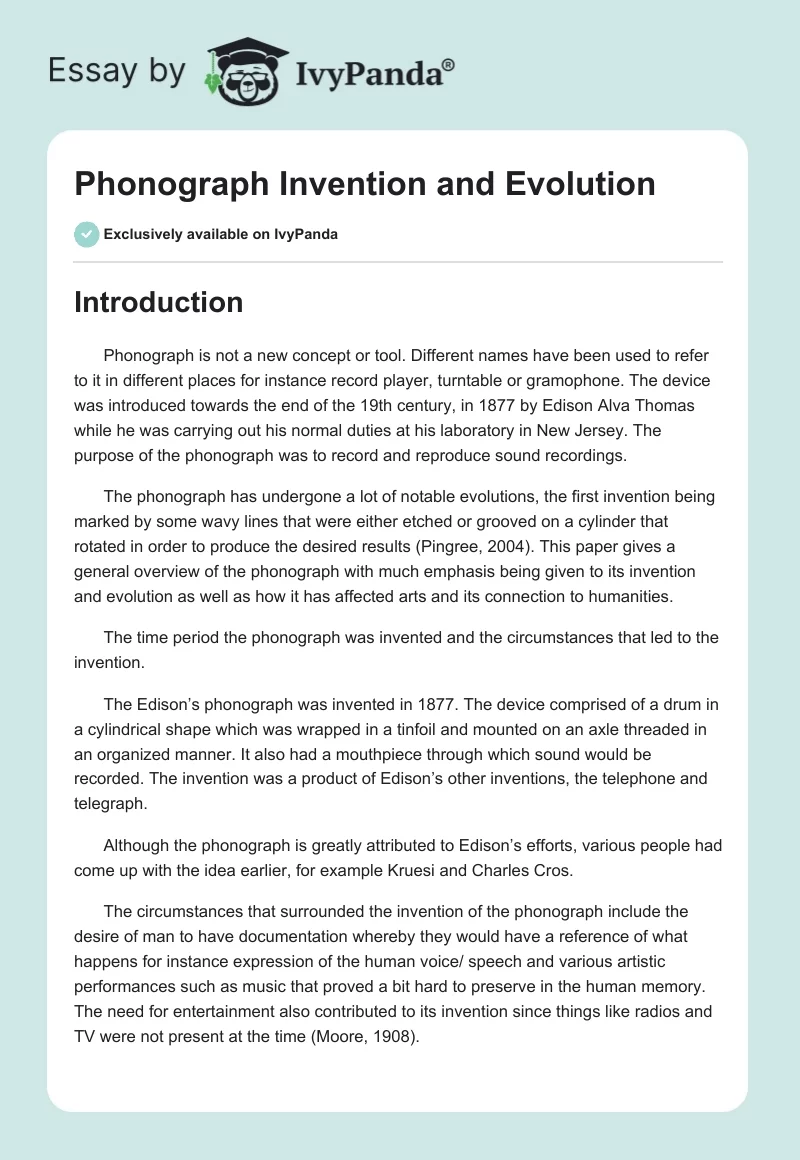Introduction
Phonograph is not a new concept or tool. Different names have been used to refer to it in different places for instance record player, turntable or gramophone. The device was introduced towards the end of the 19th century, in 1877 by Edison Alva Thomas while he was carrying out his normal duties at his laboratory in New Jersey. The purpose of the phonograph was to record and reproduce sound recordings.
The phonograph has undergone a lot of notable evolutions, the first invention being marked by some wavy lines that were either etched or grooved on a cylinder that rotated in order to produce the desired results (Pingree, 2004). This paper gives a general overview of the phonograph with much emphasis being given to its invention and evolution as well as how it has affected arts and its connection to humanities.
The time period the phonograph was invented and the circumstances that led to the invention.
The Edison’s phonograph was invented in 1877. The device comprised of a drum in a cylindrical shape which was wrapped in a tinfoil and mounted on an axle threaded in an organized manner. It also had a mouthpiece through which sound would be recorded. The invention was a product of Edison’s other inventions, the telephone and telegraph.
Although the phonograph is greatly attributed to Edison’s efforts, various people had come up with the idea earlier, for example Kruesi and Charles Cros.
The circumstances that surrounded the invention of the phonograph include the desire of man to have documentation whereby they would have a reference of what happens for instance expression of the human voice/ speech and various artistic performances such as music that proved a bit hard to preserve in the human memory. The need for entertainment also contributed to its invention since things like radios and TV were not present at the time (Moore, 1908).
How the phonograph has evolved over time and the effects of the evolution on later time periods
Just like any other development, the phonograph was not invented in one day. It took some time, considerations and combination of different ideas. Its evolution has been deemed to have a lot of impact on various life aspects especially in art and humanities. The early invention involved use of tin foil cylinders. Wax cylinders were later developed to deal with problems associated with tin foils like wearing out quickly. Hard plastic cylinders were then developed in the early 20th century.
The invention and advancement of the phonograph and its operations has had a part to play on other inventions. This is because the later inventions like radio and TV have drawn ideas on the earlier phonograph and made some improvements to enhance efficiency and effectiveness (Millard, 2005).
How phonograph affected the arts within the time period it was invented
Phonograph has had a part to play in the different forms of art including music, theatre and drama among other arts. Phonograph has been deemed to have contributed positively to the field of art and humanities through bringing about diversity which in turn makes these fields interesting.
The phonograph added importance to the art arena by providing a way through which the different works would be recorded and archived for use at a convenient time by any individual that could own the instrument.
Music and drama would for example be recorded and reproduced later and this aspect contributed to the growth of the art industry where artists enhanced their talents and were able to create their presence among the public as opposed to earlier times where they would only be known at the time of performance since there was no form of retrievable storage (Du Moncel, 1974).
How the advancement of phonograph is connected to the humanities
According to Ramadhan (2011), the invention and advancement of the phonograph has not existed in isolation but rather amongst many other concepts where some form of dependence has been witnessed. It has, for example, played a great part when it comes to the field of humanities.
The phonograph has made human life easier because they don’t have to rely solely on their memory for their works. People were also in a position to bring different aspects of the world into their homes, an aspect which led to the emergence of a global culture as a result of integration of different elements from different cultures provided by the recordings. Entertainment was also enhanced by the phonograph in a great manner.
Conclusion
Technology advancement is inevitable. It is a concept that has been there all along with the speed and sophistication increasing day by day. The phonograph is an instrument that is deemed to be a reference point when it comes to the field of art and humanities especially Music.
Later developments have drawn ideas from it and made some improvements. There are various circumstances that surrounded the invention of phonograph as mentioned earlier and with the changes of times, there have been implementation of modifications in making of instruments to incorporate the changes.
Reference List
Du Moncel, T.A.L. (1974). The Telephone, the Microphone and the Phonograph. New York: Arno Press.
Millard, A.J. (2005). America on Record: A History of Recorded Sound. Cambridge: Cambridge University Press
Moore, C.C. (1908). A Treatise on Facts: Or, the Weight and Value Of Evidence, Volume 1. New York: Thompson Company.
Pingree, B.G. (2004). New Media, 1740-1915. New Jersey: MIT Press, 2004.
Ramadhan, A. (2011). Facts about the Phonograph. Web.


